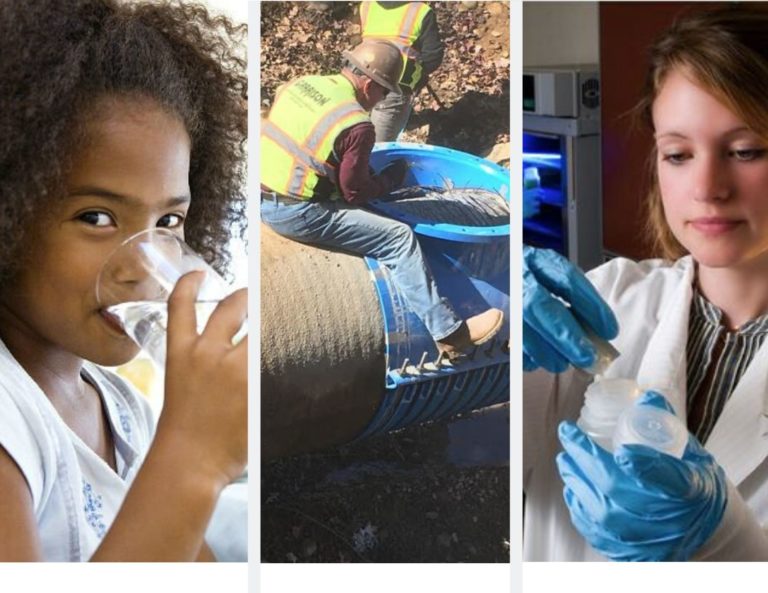We’ve heard a lot following this month’s waterline break!
As we continue to invest millions of dollars in our water delivery system, there may be disruptions. While City staff do their best to minimize the inconvenience of water outages and boil water advisories, they will unfortunately happen from time to time. And we are doing everything we can to minimize those disruptions.
The City of Asheville has an award-winning water system fed from protected pristine mountain streams.
We’d like to take this opportunity to share information about the focused and detailed work that goes into delivering that water every day, as expected.
Water quality testing

The City of Asheville maintains 1,800 miles of waterline serving 124,300 residential, industrial and commercial customers. Providing clean, safe water to those customers is of paramount importance — and a charge City staff takes very seriously.
Our water is laboratory-tested 50 times a day or more. This includes the continuous routine testing conducted at the North Fork, William DeBruhl, and Mills River water production facilities plus additional testing of samples collected throughout the system.
Award-winning quality
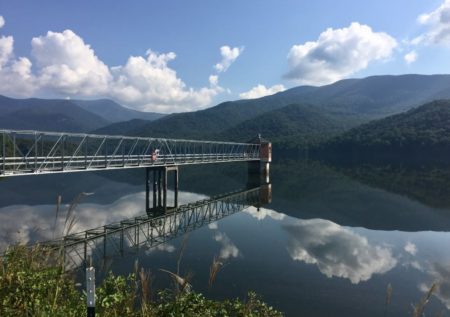
In 2019, the City of Asheville released its 20th annual Water Quality Report, a federally-mandated “report card” designed to educate customers on what is in their drinking water. The City of Asheville is pleased to report that the City’s drinking water continues to surpass all U.S. Environmental Protection Agency (EPA) Safe Drinking Water Standards. The report is available on the Water Resources webpage on the City of Asheville website under “Reports.”
Our primary sources of water are located in eastern Buncombe County where the water flows from pure mountain springs and streams into lakes known as the North Fork and Bee Tree Reservoirs. They are located in Black Mountain and Swannanoa, respectively. These pristine lakes are surrounded by 20,000 acres of highly protected mountain forests owned by the City of Asheville.
Proactively maintaining our system
The City of Asheville continues to make significant investments in maintaining and improving our water system — $12.2 million in Capital funds are budgeted for the current fiscal year alone. Water Resources staff has replaced over 21,000 linear feet of pipe this year as well, projects funded through operating funds.
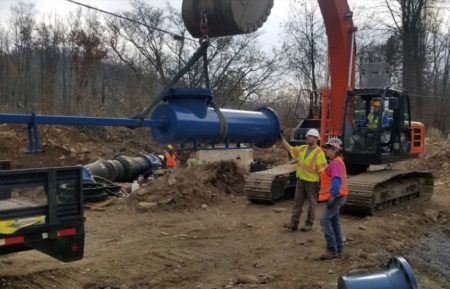 Here’s how the proactive maintenance of our valued water system works:
Here’s how the proactive maintenance of our valued water system works:
Waterline breaks are mapped and analyzed to assess where the City needs to focus their waterline replacement efforts. Much of the time when the older problematic waterlines are replaced, the pipe sizes are increased in order to provide adequate supply and fire protection to existing customers. Water Resources staff conducts this process of mapping and analyzing the waterline breaks on a yearly basis. With this information staff can prioritize the most critical waterlines for replacement and develop Capital Improvement Projects for replacing those waterlines.
The City also identifies and prioritizes Capital Improvement Projects (CIP) through needs assessments such as the water system master planning process. These types of assessments generally identify issues with the water system other than lines that frequently break due to the age.
An issue that is typically identified through master planning would be when a water main is at or near capacity, meaning stresses are predicted due to the velocity of water coming through them. Those lines are then prioritized for replacement with larger sized waterlines or additional redundant lines to add capacity and reduce stresses on the system. Examples:
- The Tunnel Road/Kenilworth waterline project nearing completion is an example of this proactive maintenance.
- The $2.1 million North Fork Bridge Transmission Line Bypass Project installed in 2019 was another one.
Designed to better protect the Asheville Water System from widespread outages or a complete failure, the Nork Fork Bridge Transmission project included installation of 1,700 feet of 36-inch transmission waterline with tie-ins to existing 36-inch and 24 inch-transmission lines to the north and south of the bridge crossing of the North Fork of the Swannanoa River.
The Capital Improvement Projects (CIP) fees on your utility bill helps fundall of these system improvements.
Breaks
Water Maintenance has a goal of repairing breaks within four hours, once they get to a scene. They are able to achieve this most of the time. Sometimes the complexity of a break can require a longer time to repair.
Two significant breaks of 24-inch water transmission lines occurred in April 2019 and January 2020. This most recent break occurred 20 feet underground, which required excavation time to get to the broken pipe.
What caused these two breaks? The 2019 transmission line break in the River Arts District occurred when the line was relocated as part of a road improvement project. The January 2020 break was due to aging infrastructure.
Gravity and topography are factors too
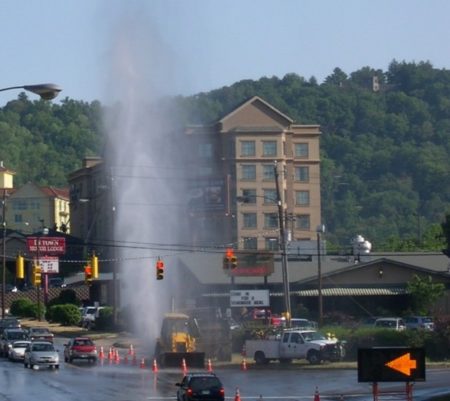
You do not see a tall water tower tank in Asheville. Because of our mountainous topography, some areas of our system have a much higher level of water pressure. This higher water pressure produces a greater number of breaks in waterlines. Some of the factors:
- 1,500 feet in elevation changes;
- More than 50 different pressure zones throughout the infrastructure; and
- Water pressures in excess of 400 psi in some locations.
The City addresses this by using a system of pumping and storage tanks used to lift / push the water to elevations that cannot be supplied by the gravity pressure, such as up to Town Mountain. Water Resources also has a:
- Valve and Leak Detection Crew focused on proactive leak detection and repair and valve maintenance;
- Pressure Team that helps address pressure optimization in high-pressure areas; and
- Projects that consisted of the installation of 23 master meters to better regulate and control existing pressure zones.
These proactive measures have earned Water Resources a national reputation in best practices for managing a high-pressure water system. Our staff routinely give presentations at national meetings about how this is achieved here.
Boil water advisories and notifications
When significant breaks occur, the City may issue a Boil Water Advisory (BWA). In 2016, the City implemented the boil water advisory program in the event of pressure going below a certain level (below 20 psi) during a water pipe replacement or emergency repair. This is a best practice required by the NC Department of Environmental Quality.
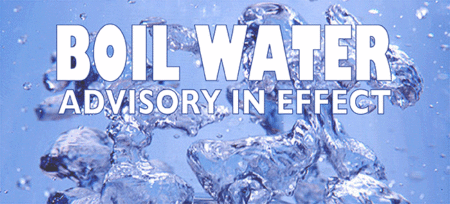 A Boil Water Advisory does not mean water is contaminated. Rather, it is issued as a precaution when water contamination is possible. During an advisory we recommend that customers vigorously boil water for at least 1 minute before consumption or drink bottled water.
A Boil Water Advisory does not mean water is contaminated. Rather, it is issued as a precaution when water contamination is possible. During an advisory we recommend that customers vigorously boil water for at least 1 minute before consumption or drink bottled water.
Customers in affected areas are notified through the AVL Alert system. The information is also posted under Water Quality and Advisories on the City of Asheville website.
It is important to note that customers need to “opt in” for AVL Alert system by signing up for it on the City of Asheville website and we encourage everyone to do so. Here is a direct link. When you sign up, you decide how you want to be notified of emergencies: email only, or to include text and/or phone/cellphone notification. We understand that middle-of-the-night notification is disruptive and try to avoid it, however notification is required at the time of the emergency.
Once a Boil Water Advisory is lifted, customers notified through AVL Alert receive notification that the advisory is lifted and the information is posted on the Water Quality and Advisories webpage. In the event of an “all system” alert, the notices will also be posted on the City of Asheville Facebook page and Twitter feed.
Addressing discolored water
Sediment stirred up in pipes once high-velocity water returns to a section of broken pipes can produce discolored water. The City recognizes this is unsightly and inconvenient. And while discolored water may not be contaminated, no one welcomes its presence.
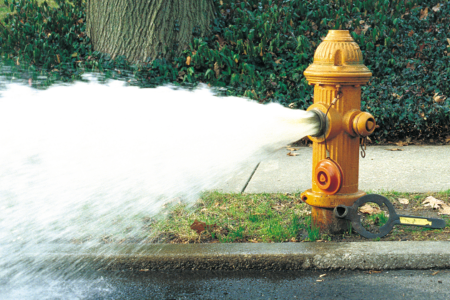 Tests have shown the presence of manganese sediment in our water system. To mitigate discolored water, the City has stepped up flushing of pipes throughout the system and is working to improve its annual flushing system. You may see fire hydrants running as part of this process to flush sediment out of the lines. City staff have also identified key flushing points that more efficiently remove discolored water from the system, therefore you may not see the flushing in your local area.
Tests have shown the presence of manganese sediment in our water system. To mitigate discolored water, the City has stepped up flushing of pipes throughout the system and is working to improve its annual flushing system. You may see fire hydrants running as part of this process to flush sediment out of the lines. City staff have also identified key flushing points that more efficiently remove discolored water from the system, therefore you may not see the flushing in your local area.
Customers who experience discolored water are advised to run cold water for 5-10 minutes or until the water is clear. If your water does not clear within 30 minutes, please let us know by calling Customer Service at 828-251-1122.
